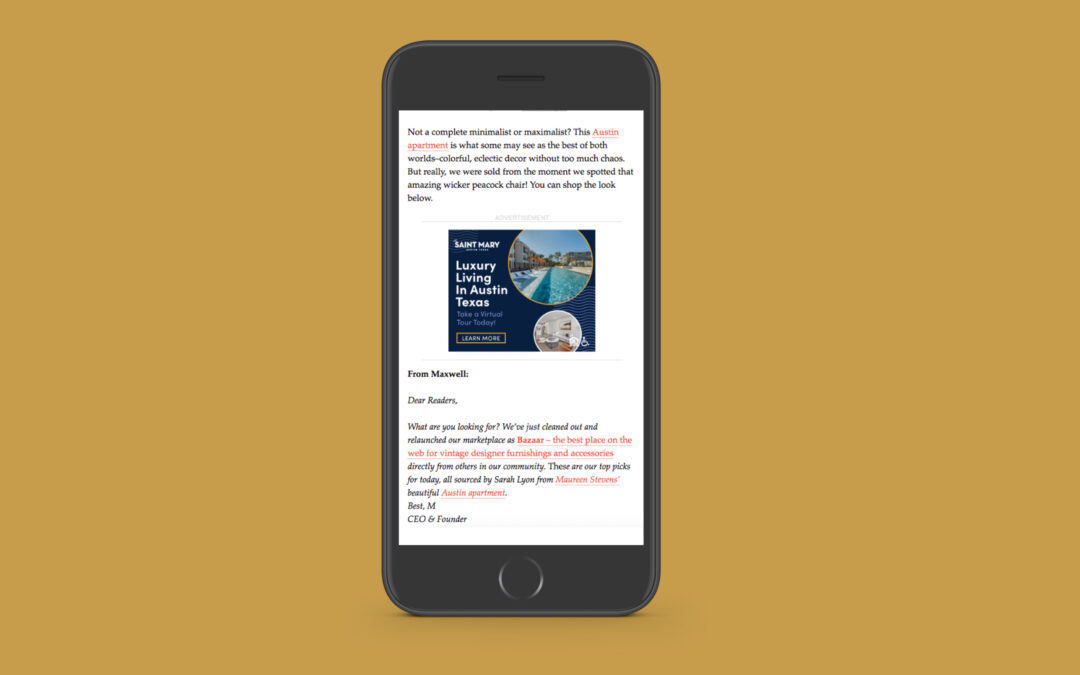
by threshold | Nov 15, 2022 | Creative, Digital Marketing, Marketing, Thought Leadership
 Laura Robbins Laura Robbins
|
You have your property amenities sorted, your pricing figured out, and your interior design developed. But what does that all mean if you don’t have a name that fully captures the specialty of your real estate building?
Choosing a brand name is one of the most significant aspects of a brand development process. The right name creates an image of your property and brand in the mind of potential customers, sharing the idea of what you’re all about. And, it’s the most important keyword for internet searches.
A strong brand name should be:
- Meaningful: It communicates a brand story and creates an emotional response
- Unique: It should be memorable and stand out from your competitors
- Easily Understood: Avoid words that are hard to read or pronounce – they won’t stick in people’s minds
- Visual: It should lend itself to strong brand colors and imagery
- Future-Proof: You want your name to work now, and ten years from now, so veer away from names that feel really timely
Work backward. Decide what your brand identity, such as target audience, culture, mission, and purpose, will be, and then begin brainstorming names that line up with those needs.
Feeling stuck? Follow along for some tips for determining a successful name for your brand.
Reflect On Your Company Values
Think about your property’s mission statement or parent company’s values – what is it your company stands for, and how can your name tie back to that? Spend time with what your property is trying to achieve, focusing on your purpose and vision. Determining the heartbeat of your brand can lead to a stronger name association down the road.
Connect Your Name To A Story
We communicate in stories, and talking about a brand is no different. Effective marketing connects to a larger target audience through storytelling, which is why your property name needs to mean something. If someone asks you why you named the property what you did, and all you have to say is that it sounded cool, you’re missing out on some really good marketing.
Think about the history of the city your property is located in, what it’s known for, or what interests your target audience has, and then go from there.
Having a great story also allows for stronger visuals (think website design, brochures, signage, temporary leasing space designs), as the logo, colors, and brand patterns all have a north star to draw from.
Less Is More
Short and snappy wins the race! You want to limit the length of your brand’s name, as anything longer than three or four syllables will only be harder for your potential audience to remember. The final name should be punchy, and this is best determined by running any potential names by those who aren’t part of the brainstorming, allowing for fresh eyes and fresh opinions.
Here is where you’ll also want to factor pronunciation into the mix. Your property name won’t only live on signage and a website, it will be said by residents in passing, and therefore shouldn’t be something that’s hard to say or spell. So remember to say any names aloud!
Remember Your Competitors
The last thing you want is to come up with a really amazing name, only to find out a direct competitor has something similar. Standing out from your competition is a key factor in your brand name and final brand visuals, which is why doing research on your market early on is essential.
Consider Creating A New Word
The best way to avoid having the same name as someone else? Create a non-dictionary word. Your name should still have meaning behind it, and not just be created out of thin air, but there are a few ways you can create new words, like:
- Mashing up two words together
- Spelling an existing word in a new way
- Creating a word where each letter stands for something
Plus, what’s more fun than being the owner of a completely new word?
Think About SEO
You heard it here first, do not skip thinking about SEO (Search Engine Optimization) when it comes to naming your brand or property. SEO plays a key factor in determining how popular a potential name is for organic and paid searches.
Say you’re naming your property Dragon (not a great name, but work with us here), then Googling that name will bring up a lot about dragons themselves, the television series “House of Dragon,” a speech recognition software called Dragon, and restaurants in your area with Dragon in the title. A generic name like that could make it hard to stand out in the very competitive search engine space.
Psst. This is why creating a new non-dictionary word might help!
In Summary
The success of your brand and property depends largely on the branding, which begins with a really great name. A name that’s meaningful to your audience, lends itself to great visuals, is short and snappy, and is easy to remember. A name that stands out from your competitors and can be relevant for your audience today, and in many years to come.
Don’t let determining a name feel overwhelming! Have fun with the process and see what unique options you come up with.
For more tips and information about company and real estate branding, take a look at the rest of our blogs, right here on our website! You can also subscribe to our email newsletter, or follow us on Instagram, Facebook, and Twitter!

by threshold | Jan 11, 2022 | Digital Marketing, Marketing, Tech/Web
Out of all the digital real estate marketing strategies available today, it can be hard to determine which strategies will best help move the needle on your leasing and sales results. After all, you’re not just choosing from the wide variety of advertising platforms out there, you’re also sifting through many different types of ad campaigns those platforms offer—so how do you make the right choice for your real estate brand?
Answering that question comes down to your marketing priorities and the results that are most important to you right now. For those who are launching digital marketing for a new development or getting the word out while occupancy rates are already stable, brand awareness tactics should be at the top of your list. Brand awareness tactics help you reach potential residents during the Awareness phase of their digital renter journey, sometimes before they’ve even begun their housing search.
Brand awareness tactics aren’t focused on getting quick conversions so much as they’re focused on, well, making people aware of your brand. That means impressions and views are the name of the game more so than clicks and conversion actions. So when focusing on brand awareness, you’ll want to select digital real estate marketing tactics that optimize for impressions and views rather than skipping straight to the click-driving, conversion-oriented tactics like lead generation ads or retargeting ads.
Here are some of the top-performing digital tactics for real estate marketers looking to drive impressions and views that increase awareness among your target audience.
Video Ads on YouTube

Since views and impressions are the name of the game with brand awareness, YouTube ads are an excellent place to start. Video ads on YouTube can be targeted to a wide audience in your area based on a variety of targeting characteristics. With an average view rate of 31.9%, YouTube ads are a great way to get in front of your audience at any stage of their renter journey, including before they’ve even performed a housing search.
Video ads are also a great awareness tactic because they are engaging and informative—far more so than a static display or search ad tends to be. You can feature more photos, value propositions and qualifying details in a 30-second video ad.
If you’re early in your development process and have limited photography or renderings to include in your video ad, that doesn’t mean you’re out of luck. Supplement your visual assets with lifestyle footage, which can be found on platforms like Adobe Stock and Shutterstock.
Social Ads on Facebook & Instagram

Social ads for apartments on Facebook and Instagram offer similar targeting capabilities compared to YouTube, giving you the opportunity to reach your audience on some of the digital spaces where they spend the most time.
There are a variety of ad types you can run on these platforms, but to reach prospects in the awareness phase, we recommend Traffic ads on Facebook and Instagram. Traffic ads are focused on driving traffic to your real estate website, so those who do click are given the opportunity to learn more about your property. When optimizing for brand awareness, we particularly recommend opting for carousel ads over single image ads because they provide a fuller glimpse of your community and provide a way for users to engage with your ad (by scrolling through the images) even if they’re not ready to click through to your website and really dive in. This provides a fuller opportunity to become intrigued and commit your brand to memory.
Addressable Marketing & Geofencing Ads
Targeting specific households, businesses, hotspots, or competitors in your area can help you raise awareness among a highly specific audience who is most likely to resonate with your brand. Addressable marketing and geofencing ads both rely on virtual “fences” drawn around specific locations within which users may be served your ad. Typically, a conversion zone is also drawn around a physical location such as your leasing office in order to measure offline conversions, but you can also measure online conversions from these ads when a targeted user visits your apartment website.
When a prospect enters the fenced location (e.g. their home address), they will be targeted with your ads on their mobile and desktop devices for 30 days. When the customer enters the conversion zone (e.g. your leasing office) with their mobile device after being served your ad, the conversion zone recognizes the prospect and attributes their visit as an offline conversion. Or, if a prospect converts online by filling out a contact form, that action is measured as an online conversion.
Addressable marketing campaigns allow you to target prospects based on household location, income level, home equity information, number of household members, and a variety of interests, contributing to highly qualified online and offline traffic down the road. By raising awareness among a highly qualified audience, you increase the chances that awareness eventually turns into action when your prospects are ready to start or continue their housing search.
One addressable marketing tactic we recommend is CTV (AKA Connected TV) ads, which allow video ads to be served to Smart TVs while your target audience is using a TV app like Hulu and other streaming services. Like YouTube video ads, these ads are more engaging than static display ads and reach prospects while they’re going about their day-to-day lives, so they’re aware of your real estate brand when it comes time for them to search for housing.
Here’s Why Addressable Marketing Campaigns Should Be Part of Your Real Estate Marketing Plan
Google Display Ads
Though video ads may on platforms like YouTube tend to be more engaging, Google display ads are also a great way to increase brand awareness among your target audience. Whether you create an animated ad or keep it simple with a static image, Google serves display ads over a vast network of partnered sites, targeting users across many of the same parameters you’ll find on YouTube ad campaigns (Google owns YouTube, after all).
Display ads are a strong choice for brand awareness because they reach users while they’re going about their normal online browsing activities, but also link directly to your website so that impressions can easily turn into traffic. And even if a user doesn’t click through when served your ad, just getting their eyes on your brand makes them more likely to convert later when they are ready to conduct their housing search and learn more about some of the options in their area.
With many different ad sizes available, you can choose a variety of placements, but the 300×250 size tends to get the most impressions and clicks.

by threshold | Dec 9, 2021 | Digital Marketing, Marketing, Tech/Web, Thought Leadership
 Written by Abby Browning, Digital Marketing Manager
Written by Abby Browning, Digital Marketing Manager
Are you finding it more and more challenging to keep up with the inevitable changes to your digital marketing platforms? Google and Facebook are constantly evolving, and so must your approach for digital real estate marketing. Recently, Google announced some changes that affect keyword behavior and ad types. We’ll review what these changes are, how they affect your digital apartment marketing, and how you can continue to drive results despite these changes.
What changes have been made to keyword match types and behavior?
In July of 2021, Google officially eliminated modified broad match keywords. Previously, ads would show for search queries that contained all of the keywords included in your modified broad match keyword, regardless of order. For example, a user could be researching moving companies Atlanta to Austin. By using a broad match modified keyword in your search strategy, “+moving +companies +atlanta +to +austin” would show ads for any query that contained all keywords, regardless of order, including moving companies from Austin to Atlanta.

As of September 2021, Google has loosened up restrictions to phrase match in order to operate more similarly to broad match modified, though they will not be an exact replacement. The main reason for Google making these changes is to boost the relevance of ads that are being served to users by focusing more on text and intent behind the query. According to Google, “The updated phrase match simplifies match types by combining the control of phrase match and the expanded reach of the discontinued broad match modifier.”
What happens moving forward?
Take this opportunity to reduce keywords in your thematically consistent ad groups by removing any match type duplicates or close variants. We recommend leveraging negative keywords to ensure that you’re filtering out unqualified traffic. The newly improved search terms report will also be a useful tool to reference to understand which keywords and match types are triggering your ads, providing insights into new keyword additions to build or exclude in your campaign.

What changes have been made to expanded text ads?
Earlier this year, Google announced that Expanded Text Ads (ETA) will no longer be available to create or edit as of June 2022. Expanded text ads have three headline fields and two description fields and are optimized for mobile. After June 2022, ETA will still be able to run, but the only changes that you will be able to make are to pause or remove them from your search campaigns.
What happens moving forward?
Google released Responsive Search Ads (RSA) in 2018, and over time, we have seen RSAs dramatically improve clicks, CTR, conversions, AND conversion rates. RSAs allow you to create ads that adapt to show more text and more relevant messages by entering multiple headlines and descriptions. Because of the responsive nature of this ad type, RSAs increase ad group performance because they help you compete in more auctions and reach more people. With the announcement of the changes occurring to ETA in June 2022, you will want to be sure that all of your ad groups contain at least one RSA as this will be the new default ad type when creating search campaigns. Now is the best time to perform A/B tests, if you are not doing this already, to see which of your ETA headlines and descriptions perform best. Save this information and be sure to use it come June! Dynamic search ads, which are ads created by Google, and call ads will still be available despite the elimination of expanded text ads.
In conclusion?
In an ever changing digital landscape, your digital marketing strategy must adapt. The changes that were recently announced by Google to keyword match types, behavior, and ad types are improvements overall. As with any shift in strategy, continue to monitor campaign performance and traffic quality driven by the updated phrase match keywords, and continue testing multiple headlines and descriptions to encourage continued interaction and engagement through the use of Responsive Search Ads.

by threshold | Nov 18, 2021 | Creative, Design, Marketing, Tech/Web, Thought Leadership
 Written by Heather Ford, Senior Designer & Web Developer
Written by Heather Ford, Senior Designer & Web Developer
People love a good story. It’s been scientifically proven that when humans hear a story that they like, it can increase their levels of oxytocin, the ‘feel good’ hormone that boosts feelings of happiness, empathy and trust. Savvy marketers have been capitalizing on this for ages, creating engaging stories for brands that resonate with people and, ultimately, persuade them to open their wallets. (Super Bowl ads, anyone?) Storytelling works in marketing because, beyond the brain hormones, it gives people a way to relate to your brand on a human level. And in the digital world we live in, this has never been more important.
While print and especially video media seem the obvious choice for this sort of humanized communication, there is another, maybe counterintuitive, area that property developers and managers can take advantage of storytelling’s powerful ability to sway the hearts of their potential tenants: their real estate website.

All good design uses color, shape, flow, imagery and copy to craft a story. Beyond these things, you can consider the common ‘three-act’ structure that many stories use when laying out the structure of a webpage:
Act 1: The Set Up. This is where your audience is introduced to the main idea of the web page they are looking at. It’s the hook that makes them keep reading, so an apartment webpage hero should be visually interesting and clear in its messaging. Act 1 in a story is also when an inciting incident happens, or a thing that drives further action. In the case of web design, this can be a strong, punchy call to action.

Act 2: The Action. This is where the bulk of the plot, or in the case of property websites the detailed information, occurs. Any text or content-heavy sections of your web page, like exhaustive lists of features and finishes, should go in the middle. Once the viewer has been introduced to the main idea of the page they are on, they can decide they want the information that is below the hero section.

Act 3: The Resolution. If you’re feeling super fancy, you can also call this the ‘denouement’. At the end of your webpage, don’t just let your content fizzle out. People have made it all the way to the bottom; they deserve a satisfying conclusion to the story. Use this as an opportunity to outline how your property solves a common pain-point for renters, or create a sense of urgency and provide a clear next-step for your users, like “Apply Now!”

A single page on your property website can encompass an entire story, or a piece (a chapter, let’s call it) in an overall story you are trying to tell about your brand. Given the way people interact with web pages, scrolling is just like page flipping. Rather than jumping randomly from page-to-page, users progress through information as a linear sequence. Because of this, a story on a website has to unfold vertically, and not in small chunks that have no visual connection between them. Unlike books, there are many ways websites can enhance this to their advantage, such as:
- Using animation. Animation on a website can be used to enhance people’s attention toward important plot points (useful information, promotions, or CTAs) and shift their attention from one place to the next, allowing you to control the flow of the story.
- Stories within stories. Embedded, interactive elements and social feeds can be used to strengthen user engagement. These are natural storytelling mediums that have been proven to improve SEO because Google knows they enhance the user experience.
- Parallax scrolling. This technique allows for interesting transitions from one section on a webpage to the next and can be combined with well-crafted illustrations and diagrams to create strong storytelling.
- Video content. Good stories use what is called “indirect characterization,” which means showing rather than explicitly telling the audience something about a character. Video content is a powerful way this can be used in apartment marketing websites. You can say that you are a family-friendly property, or you can display a video hero that shows children playing and family-friendly amenities which says the same thing—if not more—to your viewers.
Storytelling in web design is much more than words and brand voice. While these are definitely important elements, it is the unique opportunities that the digital platform offers that can really enhance a real estate brand’s story and turn a really mundane experience into a compelling one that will keep your viewers at the edge of their seat.
Sources:
1 – Speaker–listener neural coupling underlies successful communication
2 – 5 Storytelling Techniques Applied to Web Design
3 – How To Start Your Story: Story Structures

by threshold | Nov 10, 2020 | Creative, Design, Digital Marketing, General, Marketing, Thought Leadership
From apartment Facebook ads to banner ads through Google, display ads often play a central role in a real estate brand’s digital marketing mix. Since we’re a full-service apartment marketing agency here at Threshold, that means we’ve spent a lot of time perfecting our understanding of the design, messaging, and other elements that contribute to effect display ads for apartment marketing campaigns. Today, we’re passing on our must-know tips for real estate display ads.
This article will cover tips for design and messaging dos and don’ts for real estate display ads; it will NOT cover tips for how to target your ads through the various advertising platforms that support display ads (Google Ads, Facebook, Instagram, and so on). If you’re interested in a post of ad targeting tips, let us know by dropping us a line on our contact page or sending us a message on Instagram!
Keep Copy Short and Descriptive for Apartment Display Ads
When your apartment community has so much to offer, it can be challenging to keep your ad messaging short! But there are a number of reasons why it’s essential to stay brief. The primary reason is that short copy is just more effective. Users typically encounter display ads as they go about their normal online lives, and as a result, they have precious little attention to devote to your ad. Ensuring that your ad message can be parsed quickly and effortlessly is essential if you want to work within this limited attention span to reach your qualified audience and earn their clicks.
Speaking of limited attention, copy-heavy ads can crowd out more engaging elements of ad design. Data show that ads with high-quality images and video earn far more clicks and engagements than ads without these features. When you crowd your visuals with copy, you compromise the ability of the visuals to drive this performance boost.
Not only that, but the more copy you include, the less legible your message is likely to be, especially when dealing with smaller ad sizes. Keeping your message short ensures that the copy will be legible across a wide variety of devices and ad placements.
Some platforms even restrict the amount of copy you’re allowed to have on a display ad. When it comes to apartment Facebook ads, for example, apartment marketers have long been working with a restriction called the “20% rule,” which restricted the use of ad images with text on more than 20% of the image. In 2020, Facebook announced that they would be removing this rule, but still recommend that you follow the 20% guideline, as ads with less copy tend to see better results on their platform.

A Facebook display ad following the 20% rule
So, given the limited room for ad messaging, what makes for effective real estate ad copy? Most importantly, you need to provide just enough information that it’s clear what the ad is for. Remember, the user is only devoting a few seconds at most to reading your ad, so it needs to be immediately obvious what’s being advertised or you’ll lose out on the people in the audience who might actually be interested to learn more. A headline of about 3 to 5 words (or around 30 characters) is usually best. For example, “Apartments Near UMD” or “Special Rates on Austin Apartments” get to the point quickly and clearly communicate the important information that a user needs to know in order to determine if this offer is relevant to them. You have more flexibility with copy length on certain ad sizes (for example, banner ads can incorporate slightly more copy), but in general, the shorter the better, especially if you want users to click through.
As long as you’ve mastered the short and sweet headline, you may be able to drive more qualified clicks by getting as specific as you can in the space available. For example, if the ad size is large enough to accommodate it, a subheader listing the available floor plan types or a “starting at” price may be beneficial. Where a subheader isn’t possible, just be as specific as you can within the 30 characters or so you have in your headline.
Finally, for ads that feature a CTA Button, keep that short and sweet too. “Apply Now,” “Lease Today,” or “Learn More” works great for apartment display ads.
Use High-Quality, Visually-Engaging Property Photos
We already mentioned that high-quality visuals contribute to better ad results for real estate display ads. But what counts as high-quality? What photo composition elements make an ad visually engaging?
We have an entire article devoted to answering exactly that question, which you can find here. In short, the angle, lighting, and staging of the photo all make a difference, as does the color composition (more on color below). The image should also have a single, clear focal point. If the user isn’t sure where to look, they’re not going to waste time figuring it out, they’ll just scroll right past your ad.
If good photos or renderings aren’t available, lifestyle imagery may work better than using a poor-quality photo. Stock images featuring one or two smiling people who fall into your renter demographic are common options.

A retargeting ad using a lifestyle photo
Use Bold Colors and High Contrast When Designing Your Real Estate Display Ads
Use bright colors to draw consumer attention to your ad. This is especially important with call-outs and buttons, which should be contrasting colors for high visibility. This doesn’t mean your ad should be garish; a little knowledge of complementing colors can go a long way when you want to use bold colors while still being easy on the eyes. For example, if you use a photo for your banner ad with a blue sky background consider an orange button and orange action text.
Bear in mind, though, that your branding should be consistent between your display ads and the landing page the ad links to, so use brand colors as a starting point. Ensuring that your apartment’s display ads make use of your brand’s colors and fonts make the ad’s look and feel consistent with the website. This also avoids confusing users by making them think they clicked on the wrong link.

A banner ad using contrasting colors
Tailor Ad Sizes To the Type of Apartment Display Ad Campaign You’re Running
Some ad sizes statistically perform better than others, but your choice of which ad size(s) to use for your apartment display ad campaign may be more complicated than it appears at first glance. That’s because different ad sizes are better for different goals.
For example, if your goal is to maximize impressions, ads that are 300×250 or 728×90 pixels may be your best bet. However, if your goal is to earn clicks, the highest-performing ad sizes tend to be 336×280 and 300×600 pixels. Let’s break that down a little further. That means that if you’re running an awareness campaign, where impressions are a more important factor, the 300×250 and 728×90 ad sizes may suit you perfectly. However, if you’re hoping to drive immediate leasing results, you need people to actually click through. In this case, 336×280 or 300×600 may be your better choice.

A 728×90 Retargeting Banner Ad
Your best sizing choice may further vary depending on what type of campaign you’re running. For example, smaller ad sizes for retargeting campaigns may work better because the user is already somewhat familiar with your brand and the ad can help you stay top-of-mind no matter how small it is. But for new traffic or lead gen campaigns, larger ad sizes give you a better opportunity to showcase why a user should bother to learn more. The ad size you choose may also depend on the message you need to deliver. If you need more room to accommodate a longer message (say, a special rate on specific floor plans), then a 728×90 banner ad like the one pictured above may work well.
Those are all our top tips for creating effective display ads for apartment marketing campaigns! If you have more questions, don’t hesitate to reach out to our team! We’re always happy to talk digital marketing strategy.


 Laura Robbins
Laura Robbins



 Written by Abby Browning, Digital Marketing Manager
Written by Abby Browning, Digital Marketing Manager


 Written by Heather Ford, Senior Designer & Web Developer
Written by Heather Ford, Senior Designer & Web Developer








